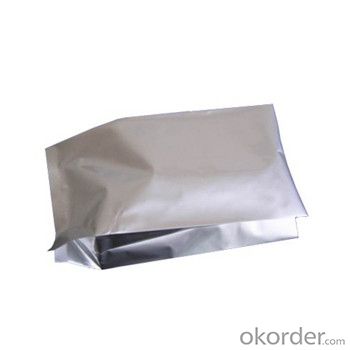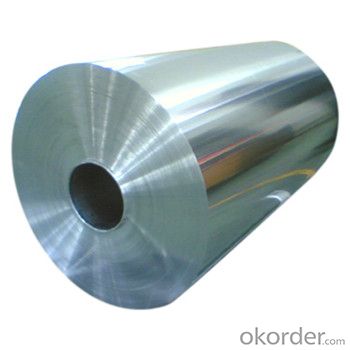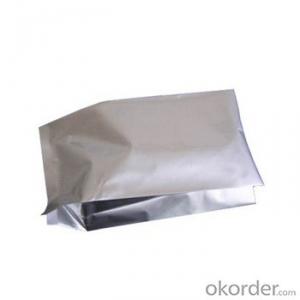Aluminium Jumbo Foil For Flexible Packaging Application
- Loading Port:
- China main port
- Payment Terms:
- TT OR LC
- Min Order Qty:
- 3 m.t
- Supply Capability:
- 10000 m.t/month
OKorder Service Pledge
OKorder Financial Service
You Might Also Like
Item specifice
1. Description of Aluminium Jumbo Foil For Flexible Packaging Application
Aluminum foil aluminum alloy :1235 /8011/8079
Aluminum foil width and length :according to your request
Aluminum foil Core ID :76.2mm &152mm
Aluminum foil temper : o /h12 / h24
Final usage: insulation aluminum foil / lidding aluminum foil /tag and lable aluminum foil / container aluminum foil / food and pharmaceutical packing foil / cigarette aluminum foil
2. Specifications of Aluminium Jumbo Foil For Flexible Packaging Application
Product | Alloy | Thickness | Width | ID mm | Remark |
| Cable wrap foil | 1235/8011-O | 0.2-2.0mm | 60-1700mm | 76 152 200 300 400 500 | Accept customization |
| Bottle cap foil | 8011-H14/H16 | ||||
| Household foil | 1235/8011-O | 0.005-0.2mm | 100-1700mm | ||
| Container foil | 3003-H24/ 8011-H24 | ||||
| Flexible packingfoil | 1100/1235/8011-O | ||||
| Lable foil | 8011-O |
3. Feature of Aluminium Jumbo Foil For Flexible Packaging Application
*Such coil is specially designed to replace aluminum ingot, due to the high export tax of aluminum ingot, the coil has better price than ingot.
*This type of coil can fit customer's remelting furnace just like ingot, no need to make any change to the production line that was previously used for ingot. The standard coil size and weight is very suitable for the feed gate of furnace.
*This type of coil causes less material wastage than ingot when remelted.
*Our coil is made directly from ore, no need to go though the ingot making process, quality is much better than other suppliers who use ingot scrap to make coil.
Be free from Oil Stain, Dent, Inclusion, Scratches, Stain, Oxide Dicoloration, Breaks, Corrosion, Roll Marks, Dirt Streaks and other defect which will interfere with use
4. Certificate:
SGS and ROHS(if client request, paid by client), MTC(plant provided), Certificate of Origin(FORM A, FORM E, CO), Bureau Veritas and SGS (if client request, paid by client), CIQS certificate
5. Image of Aluminium Jumbo Foil For Flexible Packaging Application


6. Package and shipping of Aluminium Jumbo Foil For Flexible Packaging Application
eye to sky
eye to wall
with wooden pallet (wooden case also available)
7. FAQ
1) What is the delivery time?
Dpends on actual order, around 20 days
2) What is the QC system:
We have QC staff of 20 persons and advanced equipment, each production is with MTC traced from Aluminum ingot lot.
3) What market do you mainly sell to?
Australia, America, Asia, Middle East, Western Europe, Africa etc
- Q:What are the different coil coating options available for aluminum coils?
- Aluminum coils have various options for coil coating, each with its own unique benefits and properties. These options include: 1. Polyester: Polyester coil coating is a cost-effective and durable choice. It provides resistance against weathering, UV rays, and chemicals. Polyester coatings come in a wide array of colors and finishes, making them suitable for various aesthetic uses. 2. Polyvinylidene Fluoride (PVDF): PVDF coatings are highly durable and offer superior resistance against UV rays, weathering, and chemicals. They retain their color exceptionally well and can withstand harsh environmental conditions. PVDF coatings are commonly used in architectural applications that require long-term durability and appealing aesthetics. 3. Polyurethane: Polyurethane coil coatings are known for their excellent adhesion, flexibility, and impact resistance. They have a high gloss and vibrant colors. Polyurethane coatings are often used in applications that demand superior resistance against abrasion, such as appliances and automotive components. 4. Epoxy: Epoxy coil coatings provide excellent protection against corrosion and possess strong adhesion properties. They are frequently used in industrial applications that require resistance against chemicals and harsh environments. Epoxy coatings can be applied as either a primer or a topcoat, depending on specific needs. 5. Acrylic: Acrylic coil coatings offer good resistance against weather, color retention, and gloss. They are commonly used in outdoor applications where exposure to UV rays and environmental conditions is a concern. Acrylic coatings can be formulated to achieve different levels of durability and flexibility. 6. Silicone Modified Polyester (SMP): SMP coil coatings combine the advantages of polyester and silicone, resulting in enhanced weather resistance and durability. They maintain their color and gloss exceptionally well and exhibit resistance against chalking. SMP coatings are frequently used in architectural and industrial applications. When selecting the appropriate coil coating option for aluminum coils, it is crucial to consider the specific requirements of the application, including durability, aesthetics, and environmental conditions. Seeking advice from a coil coating expert can help determine the best option based on desired performance and appearance.
- Q:What are the common surface treatments for aluminum coils in the marine industry?
- The common surface treatments for aluminum coils in the marine industry include anodizing, painting, and powder coating.
- Q:Who knows about how much money can be sold in a three metre high similar aluminum door?
- Aluminum is not valuable now. Look at it
- Q:Can aluminum coils be used in the production of chemical storage tanks?
- Yes, aluminum coils can be used in the production of chemical storage tanks. Aluminum is a durable and corrosion-resistant material, making it suitable for containing various chemicals. Additionally, its lightweight nature allows for easier handling and installation of the storage tanks.
- Q:Can aluminum coils be used in aerospace heat exchangers?
- Yes, aluminum coils can be used in aerospace heat exchangers. Aluminum is a commonly used material in the aerospace industry due to its lightweight and high thermal conductivity properties. Heat exchangers are crucial components in aerospace systems, responsible for transferring heat from one medium to another. Aluminum coils are highly effective in conducting heat, making them suitable for use in aerospace heat exchangers. Additionally, aluminum is corrosion-resistant, which is important in the harsh environments encountered in aerospace applications. Its low density also contributes to fuel efficiency by reducing the overall weight of the aircraft. Therefore, aluminum coils are a preferred choice for aerospace heat exchangers due to their excellent thermal conductivity, lightweight properties, and resistance to corrosion.
- Q:Automotive aluminum coil, using GB H22, what brand, what are the main ingredients?
- 5754-H22 aluminum sheet has the characteristics of medium strength, good corrosion resistance, weldability and easy processing. It is a typical alloy in Al-Mg (mg Al alloy) alloy.
- Q:How are aluminum coils processed and fabricated?
- Aluminum coils go through a series of steps to transform them into desired forms for various uses. Typically, the process includes the following steps: 1. Manufacturing Coils: Aluminum coils are initially made by melting aluminum ingots and casting them into large, flat coils. These coils are then rolled through rolling mills to achieve the desired thickness and shape. 2. Cleaning Coils: After rolling, the coils undergo a cleaning process to eliminate any dirt, oil, or impurities that may have accumulated during manufacturing. This is usually done using chemical cleaning agents or mechanical scrubbing techniques. 3. Annealing Coils: Annealing is a heat treatment process where the coils are heated to a specific temperature and slowly cooled. This process helps to relieve internal stresses, enhance the coil's mechanical properties, and improve its formability. 4. Slitting Coils: In this step, the large coils are cut into narrower strips or sheets of desired widths. A slitting machine is used to accomplish this, allowing for better material utilization and ensuring the coils meet the required dimensions for further processing. 5. Treating Coil Surfaces: Aluminum coils often undergo surface treatments to enhance their appearance, improve corrosion resistance, or provide additional protection. Common treatments include anodizing, painting, or applying a protective coating. 6. Fabricating Coils: Once cleaned, annealed, and treated, the coils can be further processed into various shapes and forms. Common fabrication techniques include stamping, bending, deep drawing, roll forming, welding, and machining. These processes allow for the transformation of aluminum coils into components such as sheets, plates, tubes, profiles, or intricate designs. 7. Controlling Quality: Throughout the entire processing and fabrication stages, strict quality control measures are implemented to ensure that the final products meet the required specifications and standards. Regular inspections and tests for mechanical properties, dimensional accuracy, surface quality, and other relevant parameters are conducted. In summary, the processing and fabrication of aluminum coils involve a combination of metallurgical, mechanical, and chemical processes. These processes aim to enhance the properties of aluminum, improve its formability, and create a wide range of products for various industries such as automotive, construction, aerospace, and packaging.
- Q:How do aluminum coils compare to other metal coils in terms of cost?
- Aluminum coils are generally more cost-effective compared to other metal coils due to the lower cost of aluminum as a raw material and its abundance in nature. Additionally, aluminum coils offer superior corrosion resistance, lightweight properties, and energy efficiency, making them a cost-efficient choice in various applications.
- Q:How are aluminum coils annealed?
- Aluminum coils are typically annealed through a process known as heat treatment. This involves heating the coils to a specific temperature and then slowly cooling them down. The purpose of annealing is to soften the aluminum and improve its ductility, making it easier to work with. The first step in annealing aluminum coils is to clean them thoroughly to remove any contaminants. The coils are then placed in a furnace, which is heated to the desired temperature. The temperature and duration of the annealing process depend on the specific grade and thickness of the aluminum being treated. Once the coils reach the desired temperature, they are held at that temperature for a predetermined amount of time. This allows for the internal structure of the aluminum to become more uniform and relieves any internal stresses that may have developed during the manufacturing process. After the annealing process is complete, the coils are slowly cooled down in the furnace. This slow cooling is important to prevent the formation of any new internal stresses. Once the coils have cooled to room temperature, they are ready for further processing or use. In some cases, a process known as quenching may be used after annealing. Quenching involves rapidly cooling the aluminum by immersing it in a quenching medium, such as water or oil. This can help to further improve the mechanical properties of the aluminum, such as its strength and hardness. Overall, the annealing process for aluminum coils is a carefully controlled heat treatment that aims to improve the metal's properties and make it more suitable for various applications.
- Q:Should the aluminum roll be in the direction of the aluminum roll length or width?
- Grade two subgrade width is 10.0m. When setting up the slow lane, the width of the new standard subgrade is 15m and 12m respectively, while the original standard is 17.0m, corresponding lane 14.0m.Provincial standard is 20m, but must be hard shoulder, the corresponding pavement width of 10.5m, 8.5m.The highway bridge, a special highway, using integrated superstructure, median and shoulder width of appropriate narrow, but should not be less than the minimum value of the corresponding standard 28m subgrade, bridge deck width is 26m.
1. Manufacturer Overview |
|
|---|---|
| Location | |
| Year Established | |
| Annual Output Value | |
| Main Markets | |
| Company Certifications | |
2. Manufacturer Certificates |
|
|---|---|
| a) Certification Name | |
| Range | |
| Reference | |
| Validity Period | |
3. Manufacturer Capability |
|
|---|---|
| a)Trade Capacity | |
| Nearest Port | |
| Export Percentage | |
| No.of Employees in Trade Department | |
| Language Spoken: | |
| b)Factory Information | |
| Factory Size: | |
| No. of Production Lines | |
| Contract Manufacturing | |
| Product Price Range | |
Send your message to us
Aluminium Jumbo Foil For Flexible Packaging Application
- Loading Port:
- China main port
- Payment Terms:
- TT OR LC
- Min Order Qty:
- 3 m.t
- Supply Capability:
- 10000 m.t/month
OKorder Service Pledge
OKorder Financial Service
Similar products
New products
Hot products
Related keywords




























